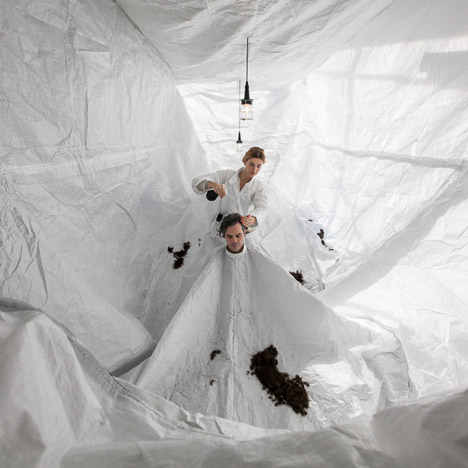Dezeen promotion: the third edition of Beijing Design Week will take place from 26 September to 3 October in the Chinese capital.
Beijing Design Week 2013 will include events, lectures and exhibitions across the city as part of a programme curated by Beatrice Leanza.
The Main Exhibition at the China Museum of Digital Arts will focus on Smart Cities, using Beijing as a case study.
The ancient Dashilar hutong district will host installations and pop-up shops, along with a lab set up to generate ideas for preserving Beijing's historical alleyways.
Designers based in the Caochangdi creative community will present their latest projects, plus interior design, furniture and fashion showrooms in the 751 D-Park will open their doors to visitors.
After it was duplicated all over the country, Florentijn Hofman's giant rubber duck will be exhibited to emphasise problems with copyright in China.
This year's guest city Amsterdam will showcase a range of Dutch art and design, led by designer Marcel Wanders.
Highlights from last year included a constellation of illuminated ceramic yoghurt pots installed in a former bicycle factory and Nike shoe material strung around a rusting gas tower. See all our coverage of Beijing Design Week 2012 »
For full event listings and the latest news visit the Beijing Design Week website.
The information below is from the event organisers:
Beijing Design Week (BJDW) returns to enliven China's capital with a unique city-wide showcase of initiatives celebrating creativity and innovation from the design field at large. Beijing Design Week 2013 will be held from 26th September to 3rd of October 2013.
With Beijing designation as City of Design by UNESCO in 2012, BJDW reinforces its positioning as an on-going observatory, acting both as an infrastructural provider and a cultural connective system. While assisting the cultivation and development of the local design industry, it makes itself referent for an international community of makers and thinkers as a catalyst of ideas, forward-looking solutions and academic explorations originating from, challenged and inspired by the contemporary predicament of global China.
BJDW 2013 proposes an established format of key sections, including: Design Forum with leading figures and policy makers from the global industry in cooperation with CCTV and The New York Times; a Main Exhibition produced and hosted by the China Museum of Digital Arts (CMoDA) continuing its curatorial focus on Smart Cities taking Beijing as a case study; Design HOP series of exhibitions, the largest component of Beijing Design Week program embraces three main core areas; the Guest City program, this year taken up by Amsterdam; the annual Design Award devoted to local innovators and a renewed trading platform dubbed Design Market, covering from household, to IT and automotive sectors.
Under the new creative direction of Beijing-based curator Beatrice Leanza, the overall program of BJDW 2013 looks at creating a meaningful narrative across its various outlets, by aggregating perspectives from current design discourse and practice into an experiential storytelling taking Beijing as its theatre of action.
From traditional alleys of old Beijing to the surreal atmosphere of new hubs of contemporary art and design, one of the most dynamic sections of Beijing Design Week is Design Hop that this year shall activate the resourcefulness of design thinking by sustaining long-term initiatives unlimited to the event-focused temporality of a week kermes, and rather manifesting itself as "process"- an incubator of engaged actions and reflections.
Renouncing an overarching thematic framework as guiding device, the existing zones will showcase instead an articulated series of projects, events, exhibitions, installations, seminars and lectures as to render key investigative domains that moderate design discourse and practice within specific urban zones.
Dashilar
With traces of the imperial past enriching the facades of buildings, traditional courtyard houses, and the social context of its unique alleys, Dashilar area abounds in a richness of stories.
Following a revitalisation scheme intended to address the criticalities of micro-scale planning, contextualise discussion around "design heritage" and preservation within the social and environmental scenario of old Beijing hutongs, Beijing Design Week has launched Dashilar Pilot, inviting top international and local designers, architects, academics and universities to create a one-of-a-kind lab to generate unique ideas and plausible solutions.
Caochangdi
Tucked away on the outer edge of the 5th ring road, Caochangdi is one-of-a-kind among the 300 so-called "villages in the city" and hosts a self-motivated group of contemporary galleries, artists' studios and independent creative and educational ventures in art, design and architecture.
Caochangdi continues as a hotbed for experimental and innovation-driven research in design making and thinking, looking at the intersection of art, design and new technologies. Bringing together a host of initiatives from the local makers community and independent creators living and working in China, it will feature unique creative outputs resulting from the encounter between cutting edge digital production technologies and centuries-old crafting techniques.
751 D-Park
Situated on the ground of a former power plant, 751 D-Park has become one of the most important center in the Beijing's design scene housing interior designers, furniture showrooms and fashion firms.
In 751 D-Park (751 Intl Design Festival) an exciting new set of large scale, site-responsive projects address design as semantics of experience and place-making, with a focus on architectural experimentation, urban planning and its connections with digital culture and interactivity, as well as projects presented by leading Chinese institutions and universities like Tsinghua University and CAFA (Central Academy of Fine Arts).
Guest City Program
Led by the figure of Marcel Wanders, Amsterdam, Guest City of Beijing Design Week 2013, uses the motto Design goes Dutch to create a cross-cultural art dialogue by bringing to town several projects that wishes to involve both guest city artist and designers with the local community.

